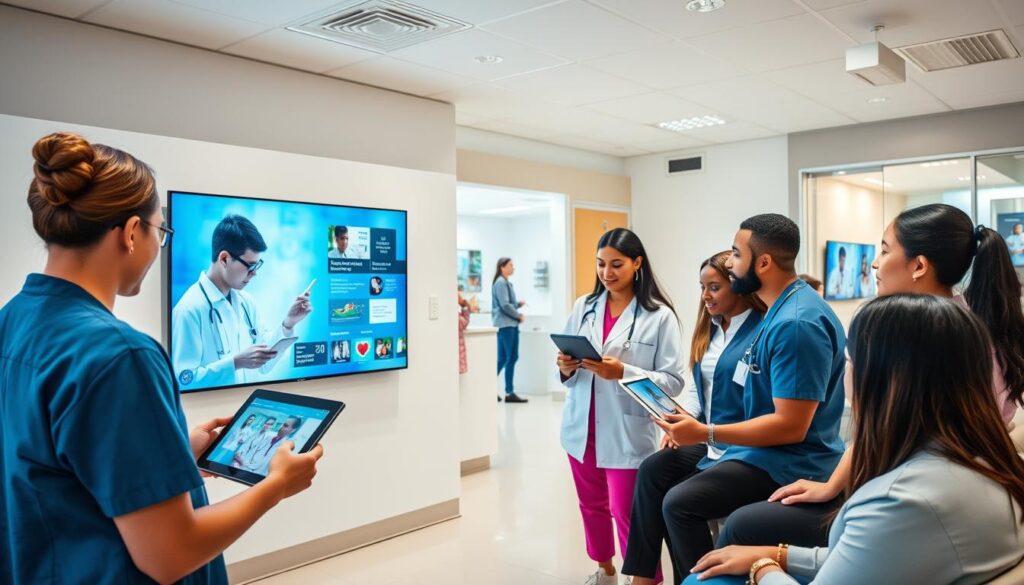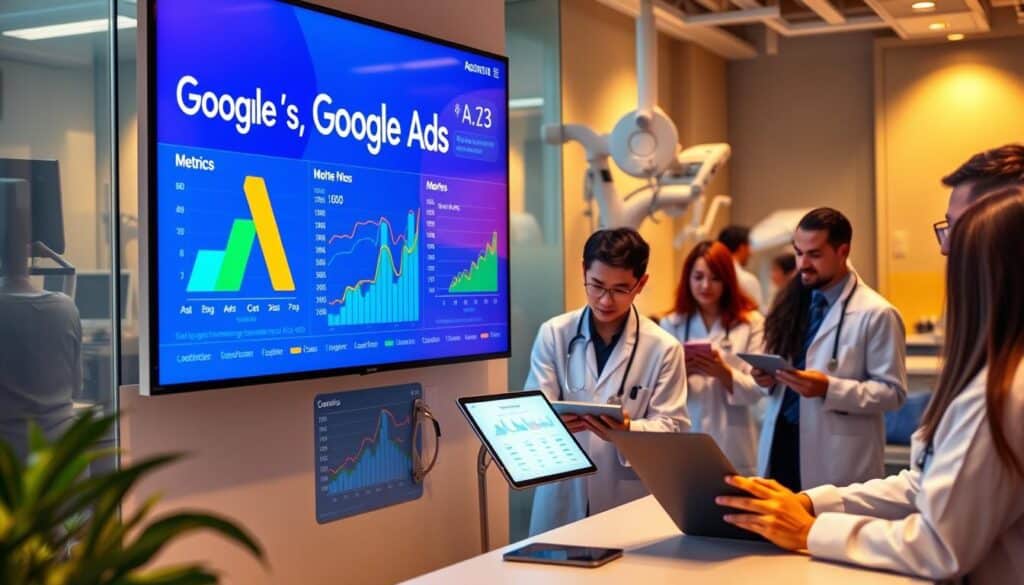The world of healthcare marketing is always changing. New trends pop up every year. It’s vital for local and national brands to keep up with the latest strategies to grow.
This article will dive into the top trends for the next few years. We’ll look at local SEO, national SEO, video marketing, and Google Ads. We’ll also cover reputation management and making the patient experience better.
Key Takeaways
- Healthcare marketing trends are rapidly changing, with a focus on local SEO, national SEO, video content, and Google Ads strategies.
- Reputation management and patient experience optimization are crucial for healthcare providers to attract and retain patients.
- Personalization, transparency, and leveraging the latest digital tools are key to successful healthcare marketing campaigns.
- Adapting to evolving consumer preferences, such as the growing demand for telehealth and AI-driven solutions, is essential.
- Comprehensive digital transformation is necessary for healthcare organizations to stay competitive and meet the needs of modern patients.
Local SEO: Balancing On-Page and Off-Site Optimization
In the world of healthcare marketing, local SEO is key. It helps practices show up online and attract local patients. By focusing on location pages and Google Business Profiles, they can boost their visibility.
Creating Location Pages and Optimizing Google Business Profiles
Practices with many locations should use a “Franchise SEO” model. Each spot gets its own page and Google Business Profile. This makes it easy for people to find the closest practice and get the info they need.
It’s important to optimize these pages with local SEO healthcare and healthcare local SEO tips. Use keywords that match the practice’s specialty and location. Make sure all info, like address and hours, is current and correct.
Optimizing Physician Profile Pages for Specialties
Healthcare practices should also optimize physician profile pages for specialties. By showing each doctor’s expertise, they attract more patients looking for specific services.
Using Google Business Profile optimization and physician profile page optimization helps practices stand out online. They connect with patients searching for their services.
“High-quality content is essential for on-page SEO, as it is pivotal in ensuring web pages are technically optimized and offer valuable and user-friendly content, thereby leading to higher rankings and increased organic traffic.”
National SEO: The Content Battleground

In the national healthcare scene, content marketing is key to winning the SEO battle. Creating top-notch, detailed educational content can bring a lot of visitors to your site. It also makes your brand a reliable source for healthcare consumers. This is crucial for national healthcare companies to stand out against big digital health players.
Consistency and High-Quality Long-Form Content
The healthcare field is very competitive. National players need a solid content strategy that adds value to their audience. They should focus on creating content that goes beyond basic info and answers specific patient concerns. By regularly publishing in-depth, authoritative content, healthcare brands can boost their SEO and become top resources in their fields.
Growing Domain Authority to Compete with Established Players
Building domain authority is vital for national healthcare companies to compete with big, well-funded players. This requires a mix of creating quality content, getting backlinks from trusted sites, and optimizing for search engines. By growing their domain authority, healthcare organizations can rank higher in search results and draw more organic traffic.
The secret to winning in national healthcare SEO is a solid content marketing plan. Focus on consistency, quality, and growing domain authority. By doing so, national healthcare companies can become trusted leaders and get ahead in the digital world.
| Metric | Value |
|---|---|
| Over 80% of people research health insurance options online before making a decision | Indicates the importance of a robust online presence for insurers in the healthcare industry |
| Expert health insurance content marketing can establish authority and credibility in the healthcare sector | By delivering accurate, well-researched information |
| Specialized health insurance content marketing helps build client trust more easily | By addressing common health issues and providing clear advice |
| Targeted health insurance marketing strategies excel at educating potential clients | By simplifying complex medical concepts and untangling jargon |
| Healthcare content writing services boost healthcare industry SEO and online visibility | Through creating targeted, keyword-rich content |
| Crafting empathetic, informative content by healthcare content writing services | Helps build customer trust and cultivate loyalty among potential clients |
By using national healthcare SEO, healthcare content marketing, and domain authority healthcare, national healthcare companies can outshine their competitors online. They can become trusted leaders in their field.
Video Marketing: The Preferred Content Consumption Method

Video marketing is a key tool in today’s healthcare world. It helps connect with patients and potential clients. With over 3.1 billion digital video viewers worldwide, healthcare can reach many people. HubSpot found that 92% of marketers see great results in keeping viewers’ attention with videos.
Studies show that watching a video makes people 64% more likely to buy a product or service. Videos can increase click-through rates by 2 to 3 times. Since people’s attention spans are short, making a strong first impression is crucial. Adding captions, transcripts, and audio descriptions makes videos accessible to everyone.
Quality thumbnails and a good call-to-action (CTA) at the end of a video boost its performance. Using high-quality music and sound effects can also make videos more emotional and memorable. By sharing videos on websites, social media, and emails, healthcare can reach more people.
The impact of video marketing in healthcare is huge. In 2023, 91% of businesses used video marketing. Marketers who use video see a 49% faster revenue growth. Videos can also increase conversions by 86%, as 85% of Americans watch online videos daily.
Patients find videos helpful for learning about medical information and treatment options. Videos are remembered 95% of the time, compared to 10% for text. By using healthcare video marketing, doctor video marketing, and video content for healthcare, practices can build trust and familiarity. This improves the patient experience and leads to better health outcomes.
“Video is the future of content marketing, and healthcare is no exception. By leveraging the power of video, practices can effectively connect with their target audience and build lasting relationships.”
| Key Video Marketing Statistics | Value |
|---|---|
| Global digital video viewers | Over 3.1 billion |
| Marketers who have seen effective results with video | 92% |
| Increase in website visitors’ likelihood to buy after watching a video | 64% |
| Increase in click-through rates with video | 2-3 times |
| Viewers who drop off after 1 minute of a video | 5% on average |
| Viewers who drop off after 2 minutes of a video | 60% on average |
| Average human attention span | 8 seconds |
| Businesses that utilize video as a marketing tool | 91% |
| Increase in revenue growth with video marketing | 49% faster |
| Increase in conversions with video content | 86% |
| American internet audience that watches online videos | 85% |
| Daily hours of content watched on YouTube | Over 500 million |
| Increase in social media shares for video content | 12 times more than text and image |
| Viewers aged 18-34 who would stop to watch a video by their favorite brand | 50% |
| Message retention rate for video vs. text | 95% vs. 10% |
Google Ads: Adapting to Performance Max Campaigns

Google Ads are key for healthcare marketing, but the game has changed with Performance Max (PMax) campaigns. These campaigns use AI to show ads on Google’s platforms like Search, Display, YouTube, and Maps.
Leveraging Video Assets for Better Results
The healthcare world is going digital, and video is more important than ever. To do well with PMax campaigns, healthcare needs to make great video ads. These ads, shown on Google platforms, can really boost marketing success.
Mastering Conversion Tracking and Negative Keywords
Getting good at PMax campaigns means knowing about conversion tracking and negative keywords. It’s important to track the right actions, like sales, to get quality leads. Also, managing negative keywords helps avoid unwanted clicks and saves money.
As healthcare marketing keeps changing, understanding healthcare google ads, Google Ads performance max, and healthcare google ads video is key. Using PMax campaigns, video, and careful tracking helps healthcare marketers succeed. They can reach and convert their audience better than ever.
“The introduction of Performance Max Campaigns (PMax) is reshaping the landscape of medical advertising, requiring healthcare marketers to adapt their strategies and embrace the evolving landscape of digital marketing.”
| Key Trends in Healthcare Google Ads | Impact on Healthcare Marketing |
|---|---|
| Shift to Performance Max (PMax) Campaigns | Requires larger budget, video assets, and focus on conversion tracking and negative keywords |
| Importance of Video Content | Enhances ad engagement and performance across Google-owned channels |
| Emphasis on Conversion Tracking | Ensures campaign optimization and high-quality lead generation |
Reputation Management: Driving Google Business Profile Growth

In today’s digital world, managing a healthcare practice’s online reputation is key. Patients often check online reviews to decide where to go for care. Having a strong Google Business Profile can help attract and keep patients.
Gathering and Responding to Patient Reviews
Getting and responding to patient reviews is vital for growth. Research shows 70% of patients check reviews before choosing a doctor, and 40% won’t go to a doctor with bad reviews. Encouraging patients to leave feedback helps build a good reputation and shows how to improve care.
Also, quick and polite responses to negative reviews can protect a doctor’s reputation and gain trust. Studies reveal 45% of patients are more likely to visit a doctor who responds to bad reviews. This highlights the need for active reputation management.
Practices that quickly respond to reviews tend to keep a positive image online. Sharing good reviews on social media can also draw in new patients. A Harvard Business School study found a 1-star increase on Yelp could raise revenue by 5-9%.
In conclusion, managing a healthcare practice’s online reputation and having a strong Google Business Profile are essential. They help practices succeed online and offer top-notch care to patients.
Healthcare Marketing: Enhancing the Patient Experience

In today’s competitive healthcare world, giving patients a great experience is key. This means making healthcare websites easy to use and mobile-friendly. It also means offering online scheduling and telehealth services for convenience and accessibility.
Optimizing Websites for Better User Experience
A good healthcare website can really boost patient satisfaction and engagement. Things like easy navigation, mobile optimization, and clear content are important. By focusing on healthcare website optimization, healthcare groups can make their online presence both helpful and easy to find for patients.
Leveraging Online Scheduling and Telehealth
The use of online scheduling healthcare and telehealth healthcare has grown a lot lately. This is because patients want things to be easy and flexible. By adding these features, healthcare providers can make the patient experience smoother. Patients can book appointments, get medical advice online, and manage their health from home.
Improving the patient experience through digital strategies is vital in healthcare today. By making websites better, using online scheduling, and embracing telehealth, healthcare groups can offer a more personal and easy-to-reach healthcare journey for patients.
“94% of healthcare patients use online reviews to evaluate providers, and 77% use online search engines to initiate their patient journey.”
Content Creation and Public Relations: Building Credibility
In the healthcare world, being credible is key. Making quality content and using public relations can help. By writing articles and appearing on media, healthcare providers can show they know their stuff. This attracts new patients and boosts their brand.
Having a strong online presence is vital for healthcare groups. 66% of internet users look online for health info. Also, patients who booked appointments searched online more than others. This shows how important being online is for finding healthcare.
Dealing with medical misinformation is also a big deal. Over 70% of people have seen wrong health info. Healthcare groups need to share accurate info. By using content and PR, they can be seen as reliable sources.
Harnessing the Power of Content Creation
Healthcare groups are using content marketing to reach patients and build trust. By sharing valuable content, they can connect with their audience. This improves their reputation and gets more people involved.
Good content marketing uses personalization and data to understand patients. It makes sure the content meets their needs. This way, the content really speaks to the audience.
Amplifying Reach through Public Relations
Public relations is also key in building trust and reaching more people. Media relations, community outreach, and social media are all important. They help healthcare groups show their expertise and connect with the community.
Working with media and community groups can get healthcare in the spotlight. It shows their knowledge and leadership. This builds trust and makes them seen as experts.
In short, combining content and PR helps healthcare providers show their skills. They can address concerns and gain trust. This makes them credible voices in healthcare.
Also Read: What Is Healthcare Operations Management and Why Is It Important?
Conclusion: Embracing Digital Transformation in Healthcare Marketing
The healthcare marketing world is changing fast. New trends and strategies are key for staying ahead. By using local and national SEO, video, Google Ads, and focusing on patients, healthcare groups can thrive.
As spending on healthcare digital growth is set to hit $3.4 trillion by 2026, it’s clear we must adapt. New tech like wearable devices and AI is changing healthcare. It’s making care more personal and improving results.
To lead the way, healthcare providers need to boost their online presence. They should make engaging videos, run smart Google Ads, and manage their reputation well. By putting patients first, through easy websites and telehealth, they can build strong relationships. Using data and automation also helps make better choices and saves money.
FAQs
Q: What are the key trends shaping healthcare marketing strategies in 2024?
A: Key trends include the increased use of digital marketing, personalized content marketing, data-driven marketing tactics, and a focus on patient experience. These trends aim to enhance brand awareness and engage potential patients effectively.
Q: Why is healthcare marketing important in today’s industry?
A: Healthcare marketing is important as it helps organizations connect with potential patients, promote their services, and differentiate themselves in a competitive market. Effective marketing strategies can lead to improved patient care and increased patient acquisition.
Q: How can healthcare organizations develop effective marketing plans?
A: Healthcare organizations can develop effective marketing plans by identifying their target audience, utilizing digital marketing channels, setting measurable goals, and continuously analyzing marketing performance to adjust strategies as needed.
Q: What role does content marketing play in healthcare marketing strategies?
A: Content marketing plays a crucial role by providing valuable information to potential patients, building trust, and establishing authority. It can include blogs, videos, and social media posts that educate healthcare consumers about services and health topics.
Q: What are some best practices for healthcare digital marketing?
A: Best practices for healthcare digital marketing include optimizing websites for mobile users, leveraging SEO techniques, using social media platforms to engage with patients, and employing email marketing to nurture relationships with current and potential patients.
Q: How do healthcare marketing agencies help improve marketing efforts?
A: Healthcare marketing agencies help improve marketing efforts by providing expertise in developing tailored strategies, managing marketing campaigns, analyzing data for better decision-making, and ensuring compliance with healthcare regulations.
Q: What marketing tactics are most effective for attracting new patients?
A: Effective marketing tactics for attracting new patients include targeted online advertising, community engagement, patient referral programs, and utilizing patient testimonials to build credibility and trust.
Q: How can healthcare organizations measure the performance of their marketing strategies?
A: Healthcare organizations can measure the performance of their marketing strategies by tracking key performance indicators (KPIs) such as website traffic, conversion rates, patient inquiries, and engagement metrics on social media platforms.
Q: What is the significance of marketing technology in healthcare marketing?
A: Marketing technology is significant in healthcare marketing as it enables organizations to automate processes, analyze consumer behavior, segment audiences, and personalize communication, ultimately enhancing the effectiveness of marketing campaigns.
Q: How can healthcare marketing strategies evolve to meet changing consumer expectations?
A: Healthcare marketing strategies can evolve by staying up-to-date with emerging trends, utilizing patient feedback to refine services, incorporating innovative digital marketing solutions, and focusing on transparency and accessibility in patient care.
Source Links
- https://socialclimb.com/blog/optimizing-for-organic-or-local-seo-whats-the-difference/
- https://goodmanlantern.com/blog/health-insurance-content-marketing/
- https://mirrahealthcare.com/insights/the-ultimate-guide-to-effective-video-marketing-for-healthcare-businesses
- https://levohealth.com/the-value-of-video-marketing-in-healthcare/


